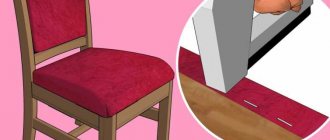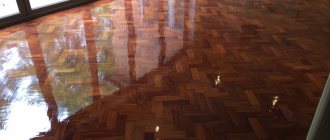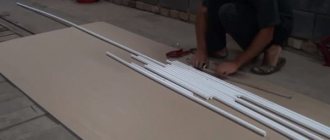The workshop is looking for permanent employment as a furniture maker. Shellac finishing training.
The workshop repairs and restores chairs made of wood, metal, leather, and upholstered chairs. as well as carved, antique, Soviet, modern. Braided, bent. Viennese, designer and so on.
Gluing a rickety chair, restoring threads, extending legs, strengthening the back - carpentry work. Refresh or renew the varnish, restore the color, perform manual polishing, including with shellac - the job of a finisher. An upholsterer, as they called it in the old days, a draper, knows how to remake a seat from sea grass and re-stretch the springs.
The cost of restoration includes all consumables.
Estimate the cost of restoration work from a photograph, call a restorer, get advice from a specialist.
It is important for the customer that the chair after restoration is comfortable, the color that was ordered, does not wobble, and is neatly upholstered with fabric. What the restorer will do is, by and large, not very interesting to the customer. But why different workshops quote different prices for the same type of work—repairing or re-gluing chairs—raises questions.
Firstly, low prices may be due to the fact that the workshop only carries out minor repairs. Demanding from such a performer complex actions, such as the color that is needed, and not the one that turned out, is simply not realistic. By the way, it is the color and quality of finishing of the wooden parts of the chair that account for the lion's share of complaints.
Secondly, the prices indicated are not for the full scope of work, but are broken down by operation. Let’s say it’s only for gluing, and the upholstery comes in a separate column. Well, the most common trick when specifying low prices is that during the restoration process hidden defects are “discovered”, for which the customer will certainly have to pay extra.
Before you give your chairs and money for repairs to strangers, look at the finished work of the master and be sure to clarify what exactly will be included in the price specified in the contract.
How much does it cost to restore a wooden chair?
Depending on the damage, prices for chair restoration are divided into three categories.
Minor chair repairs
– strengthening the frame with slight looseness. Re-gluing the chair, replacing the fabric, partially restoring the varnish. 3-5 thousand rubles.
Complete restoration of a chair
– Dismantling, cleaning the chair from dirt, darkened varnish, damaged glue, restoring threads, parts connecting parts, extending legs. Replacing the filling, upholstering with fabric or leather, decorating with carnations or braid. 10 – 15 thousand
Restoration of antique chairs.
They are more expensive not because they are antique, but because they have more damage and the technology is more complex. Most often, antique chairs from the 19th century, stored for a long time in unfavorable conditions. In the country house, attic, disassembled on the mezzanine. The carving has been partially lost, the gilding has been worn off, and the varnish has worn down to the wood.
The table shows the optimal prices for the repair and restoration of chairs with the most common types of damage.
| Chair | Minor repairs | Complete restoration with re-gluing and varnish replacement | Restoration from a ruined state |
| Hard wooden chair | 3-5 t.r. | 10-15t.r. | from 15 t.r. |
| Soft chair or floor chair | 5-7 t.r. | 10-17t.r. | from 20 t.r. |
| Antique spring chair with sea grass and horsehair | 10-15 t.r. | 20-25t.r. | Dog. |
| Empire style, classicism, shellac polished | 30-35 t.r. |
The photo shows simple living room chairs after restoration. 1. Chair with rattan mesh seat. 2.Chair with a semi-soft seat. Replacing fabric. 3. Chair with bent plywood back. 4. Soviet chair from the 60s.
These things may not be of historical value, but they are very cute and comfortable. A touching memory of a happy and carefree childhood.
In the workshop you can also order chairs to be painted in the color of the table, extend chair legs, or simply change the fabric. Restore a unique historical item with a high degree of damage.
How to update furniture?
Remaking old furniture
Chair repair
Cost of painting wood furniture
Our specialization is the scientific restoration of highly artistic furniture with a critical degree of destruction. Thanks to the use of authentic materials and work using ancient technologies, the chairs after our restoration retain their historical authenticity and can be fully used.
When repairing wooden furniture, regardless of whether it is old or new, the technologies for restoring wood are almost the same
Photos 1 and 2 show ways to extend a chair leg. Photos 3 and 4 show the gluing of the back of the chair. In both cases, the gluing area is reinforced with wooden dowels. After tinting and finishing with varnish, they are almost invisible, but it is the presence of reinforcement that provides a long-term guarantee for our work.
Seat update
While the wood frame is drying, work on the seat. Remove the upholstery from the upholstered seat. Look at the condition of the foam. Remove it if necessary. Cut out a new piece of foam and secure it to the seat using double-sided tape.
Place the old upholstery on newspaper and trace it with a pen. Cut out the pattern and transfer it to the new material. If the fabric is thin, make a backing for the foam from another dense material. Assemble the seat. Cover it with new fabric, securing it on the reverse side with staples from a furniture stapler.
Renew a dried out wooden chair frame. Remove the old varnish coating from it using a sander and sandpaper. Fill any old chips with wood putty. Prime the surface, and after drying, apply several layers of varnish with intermediate drying. Place the seat back into place.
There can be a great many reasons to renew old chairs or decorate new ones with your own hands. This includes the need to adapt furniture to the interior, the desire to correct design flaws, to restore chairs inherited from a grandmother or found for next to nothing at a flea market. In this material we will talk about 4 ways to transform “four-legged friends” (including office and garden chairs) beyond recognition, and also present 70 cool photo ideas for alterations.
Why are old chairs restored?
When antiques, chairs from the 19th and 18th centuries, are restored, this is understandable. Antiques, preserving Russian culture, investing money, luxury goods and so on. Soviet chairs from the 50s and 60s seem to have no need to be repaired. It's cheaper to buy new ones. But it's not cheaper. Anyone who has ever tried to buy good wooden chairs in modern stores knows how difficult it is to find a comfortable, beautiful, real chair. I'm talking about real, wooden ones, suitable in design, size, color and quality of upholstery.
At best, such a chair will cost 15-20 thousand rubles. Luxury restoration of a chair from the 50s and 60s is no more expensive with us.
Modern chairs or copies of time-tested models: Thonet, Chipendale, Classicism, second Rococo. Or the fantasies of modern designers. The lifespan of modern products is determined by the shelf life of the materials used. Foam rubber, glue, plastic fasteners. Machine production allows for a certain amount of defects. Cross-layered, economical gluing, inexpensive fabrics. Hence their fragility. Why buy expensive if it will break in a year or two anyway.
Old chairs are reliable friends. We survived renovations, moves, flooding of neighbors from above, weddings and student parties. If they get a little dirty, or the upholstery is worn out, then restoring them is not that expensive.
When buying wooden chairs, choose hardwoods such as oak or beech. Birch is a relatively soft tree. Chairs made from it do not last long.
Creative solutions for exclusive design
- First, paint the chair with two different colors, for example turquoise (1st layer) and white (2nd layer). Then the surface of the back and legs is carefully treated with fine-grained sandpaper to create a “scuffed” effect. The color of the upholstery material should be in harmony with the color of the painted part.
- To give the chairs a vintage flair, they are painted in cream, blue, and pink colors. After this, the entire chair or only part of it is decorated with painting. Then individual parts are highlighted with gold paint or craquelure varnish is applied to the entire surface. Small cracks will create the effect of antiquity.
Also a curious vintage
- If you want to recreate the empire style, choose milky satin with a floral print. Cover the frame with “golden” paint.
- Make a chair cover; it will not only protect the furniture from dirt, but also change its design.
Sewing a cover will take a couple of hours, even a novice seamstress can cope with such work
- The seat upholstery can be made from 30 different colored leather straps. They are intertwined with each other according to the “basket” principle and fixed from below with self-tapping screws.
Seat strapping
Patchwork – patchwork upholstery for a “bright” mood
Often there are things in the closet that have not been worn for a long time. An old shirt and worn jeans are quite suitable as “raw materials” for upholstery material for country chairs. If suitable scraps have been found, you need to select shades and cut out the component elements.
Tip: Do not use elastic materials. At first, choose simple, uncomplicated drawing schemes.
Bright accents will dilute the strict monotony
Decorating a stool using decoupage technique
Looking to update your kitchen in a low-cost way? Decoupage can make the most unprepossessing furniture original and attractive. You will need napkins or fabric with a suitable pattern; leather appliqués are also suitable.
You can find special cards for decoupage on sale.
- After sanding, the cracks are sealed with putty, the product is primed and coated with water-based emulsion.
- Then cut out a suitable picture from a napkin, spread glue on the surface of the chair and carefully apply the picture. Moving from the center to the edges, smooth it out.
- The completely dry surface is varnished.
You can decorate the seat, back or legs in this way. Decoupage is ideal for furniture in a nursery or kitchen
An excellent solution for transforming an old stool
How much does it cost to paint a chair?
There are two types of painting. Professional and artisanal. Handicraft does not mean bad, but original. There is an effect of surprise. You never know what they'll get. If you call it handicraft, with drips and unpainted marks, it’s original or designer, the prices rise significantly.
We do professional painting. It turns out exactly what you ordered. It needs to be smooth, it will be smooth. If you need it with an aging effect, preserving the wood texture or patina, you will also get exactly what you ordered.
Painting a wooden chair with suitable paint costs from 2 to 3 thousand rubles. To paint with the effect of French enamel - about 5 thousand rubles.
In order for the varnish or paint to lay evenly, first the surface is thoroughly sanded. Then it is covered with a primer layer. Liquid varnish can be used as a primer. Next, the pile is removed. Painting turns out smoother if it is done not in one dense layer, but in 2-3 liquid ones, with intermediate drying and sanding of each layer.
If the last layer of painting is done with a transparent colorless varnish, the finish will look more expensive, and the paint layer will become stronger.
Paint an already varnished chair. There are two ways. The first is simple, applicable to completely new furniture. The old finish is used as primer. We sand the entire surface, level it, and paint it. If the chair has already been used and is slightly dirty, the old varnish or paint will have to be cleaned more thoroughly.
Paint an old chair. Everything is the same as in the previous case, plus repair and strengthening of the frame, alignment or extension of the legs, re-gluing of all parts. Elimination of minor surface damage in the form of stains, dirt, scratches, potholes. Replacement of seat filling, upholstery with tapestry, leather, upholstery fabric, finishing with nails or braid... Hand finishing with a special one that emphasizes the natural color and texture of the wood. This will be called restoration of a chair; the cost of the work will be determined by the degree of destruction of the thing itself. Experience shows that such a service will cost at least 15,000 rubles, but no more.
One day a completely collapsed chair was brought into the workshop, complete with five legs. They poured everything out of the bag and asked to choose from what was available what was suitable.
When restoration is carried out, the cost depends on the time required to complete the work. A paradox arises here. The higher the qualification of the master and the better organized the work in the workshop, the lower the cost of the service. And, therefore, in the fight for the client, the workshop can afford to either reduce the price for simple repairs, or provide an exclusive service of higher quality, but at the price of regular repairs, at the average prices accepted in Moscow.
Minor chair repairs
. Essentially, this is something between routine repairs and furniture care. In the old days, furniture reupholstery was taught at the Institute of Noble Maidens. Each housewife of high origin, in addition to knowing several languages, playing the piano, and the ability to conduct small talk, possessed the wisdom of running a household, altering dresses (remember Anna Karenina), pickling mushrooms, knitting collars, sewing sofa bolsters, pillows, and reupholstering ottomans.
Seat reupholstery price
, more precisely, replacing fabric, a semi-soft chair with replacing the filling with natural materials from 1,000 to 3,000 rubles Coconut fiber, wool or cotton batting. The cost of the seat filler does not affect the price of the restoration. Nowadays foam rubber is not much cheaper than natural flooring materials.
Cost of complete restoration
wooden chair. Determined by the scope of work. It begins with removing dirt, sometimes along with old, destroyed, blackened varnish.
Next is disassembly. The operation is necessary. The old glue is destroyed and will only hinder a new reliable gluing. Therefore, so that after repair the chair does not become loose again within a year, it is necessary to remove all the old glue and build up the shrunken spines. Fit exactly and glue securely.
The tenon joints of wooden chairs dry out over time. The spikes begin to fit loosely in the grooves. There is a backlash. Hence the looseness of the chairs. To ensure that the chair never wobbles again, the tenons are built up with wood so that they fit tightly in the grooves. Next, the chair is assembled “dry” without glue. The diagonals between the legs are measured, if the legs are of different lengths, they are increased. After this, the chair is disassembled and glued together with wood glue. It is better to use a mixture of flesh glue and bone glue. Bone gives strength, and flesh gives some elasticity. Adding oils, drying oils, and antiseptics to high-quality natural glue according to ancient recipes is unnecessary.
If the chair was previously glued with PVA, STOLYAR, KLEIBERIT glue or something else based on polyvinyl acetate emulsion, the glue must be cleaned with special care, otherwise the glue will not be durable. A fresh solution will not be able to penetrate the wood fibers, and the gluing will be temporary.
We reinforce the seat drawer in the corners with “kerchiefs” or “crumbs”. After assembly, the chair is tinted with water-based stain to give the desired shade, or remains in its natural color. Finished by hand with clear varnish. All together from 15,000 to 25,000 rubles.
These are the maximum prices to date for high-quality professional restoration carried out according to the canons of scientific restoration. Thanks to strict quality control, we can provide our customers with virtually unlimited warranty periods.
Our specialization is the restoration of complex, artistic, antique, antique furniture with a high degree of damage. Carved wooden and Empire “noble” chairs require a special type of polishing. Soft spring seagrass seats and Viennese wicker furniture call for authentic materials. Modern designer or high-quality Italian and English chairs made of solid wood, gilded, painted, decorated with paintings force one to master new technologies for decorating modern luxury furniture. Over the decades of the workshop's existence, everything that was restored, repaired, reupholstered, painted, polished remained with the master restorers in the form of experience.
We treat Soviet chairs made in the 50s and 60s with special tenderness and sympathy. This is our story, childhood memories. As a rule, USSR chairs have reached us in relatively good condition.
Refreshing the color and design of old wood
The complete or partial transformation of a restored chair directly depends on the availability of certain tools and materials. Not many people know how to properly restore old chairs at home. In the process of restoring kitchen furniture, you cannot do without a drill (screwdriver), a small hammer, two different types of screwdrivers, scissors, a brush, a clamp, a stapler with mounting brackets, sandpaper, a small mallet and scissors. As the last component you will need:
- self-tapping screws;
- wood glue;
- foam pillow;
- varnish and coloring agents;
- a piece of upholstery fabric.
At the first stage of repair, the surface should be restored. The furniture is cleaned of dust and thoroughly wiped with a wet sponge. Next, the seat and back of the body are removed and the components are disassembled. Sometimes it needs to be fixed. Use a rubber mallet instead of a metal hammer to avoid damaging the parts.
If the chair is assembled with screws, the structure can be disassembled without much effort with your own hands. It is enough to unscrew them for complete dismantling. You need to fold them in such a way as not to confuse them later. To clean any remaining epoxy glue, use a dampened rag, then carefully scrape it off with an old dull knife. The cleaned frame is left to dry for some time. Only then is the structure restored and remodeled.
To remove epoxy adhesive in labor-intensive areas, use steam jet pressure instead of water. In the absence of a special device, a proven “old-fashioned” method is used to perform the delicate procedure - using a hose with a tip that is placed on the spout of a kettle to transform the tree.
Photos of chairs before and after transformation
If you find that an old chair is completely worn out, do not rush to throw it away. Often old pieces of furniture bring with them pleasant memories of people and events in your family's life. And what’s the truth? Previously, furniture was made to last...
Therefore, a restored chair may well serve not only you, but also your children. Simply by changing its appearance, you can return the furniture to its former attractiveness and novelty. Fortunately, there are many options now. Everything will depend only on your imagination.











